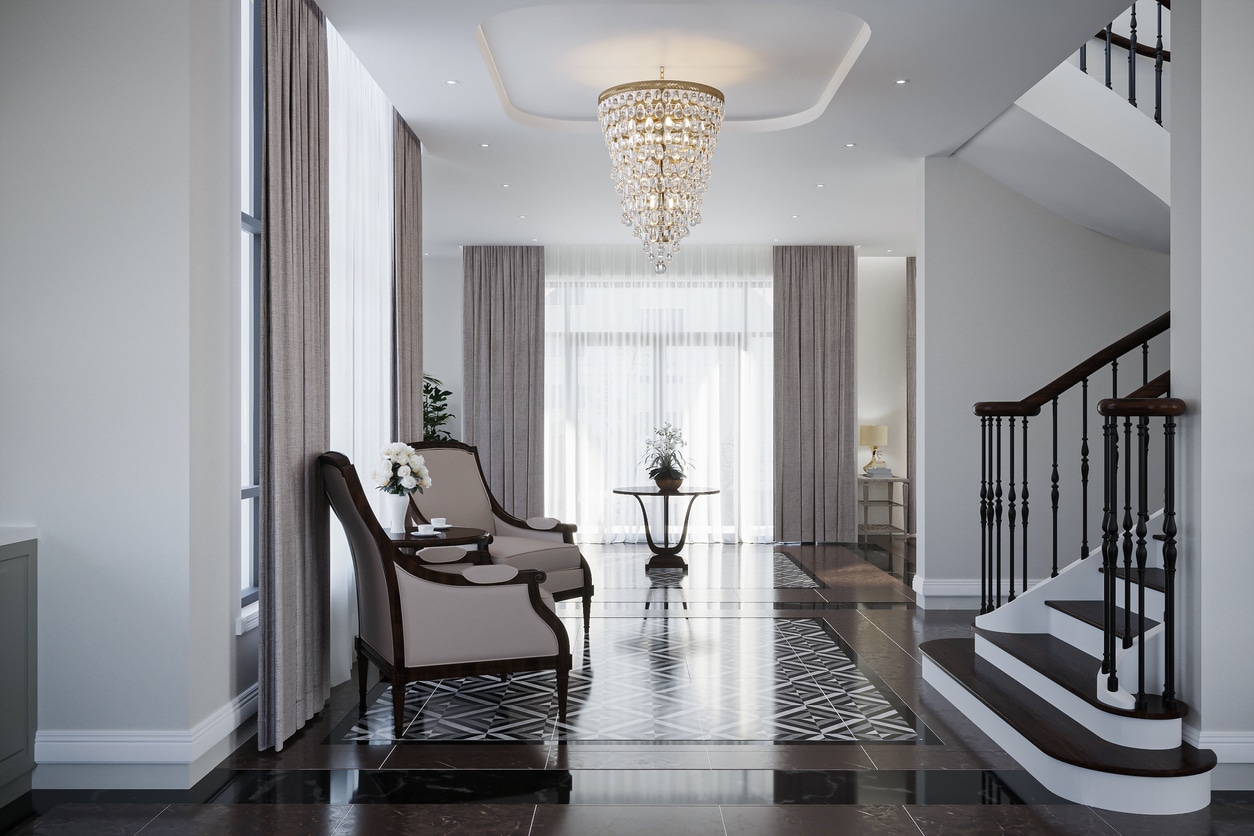When redecorating your home, one of the first choices you’ll face is whether to go for a classic or contemporary decorating style. Each approach brings its own character, practical considerations, and long-term appeal. At Alan Cox Decorating, we’ve worked on hundreds of projects where homeowners wanted timeless elegance, modern flair – or a balance of both. In this guide, we’ll walk you through what defines each style, where they work best, and how you can choose the right direction for your own space.
Whether you’re planning a full house redecoration or focusing on one or two rooms, understanding the foundations of these popular styles can help you make confident and informed decisions.

What Is a Classic Decorating Style?
Classic decorating refers to interiors that draw on traditional design elements, often with roots in British, European, or Georgian influences. It’s all about symmetry, balance, and elegance.
Key Features of Classic Style:
- Neutral and muted colours: Think soft creams, greys, warm whites, and taupe.
- Timeless furniture: Chesterfields, ornate wood frames, roll-top armchairs.
- Decorative mouldings: Cornicing, dado rails, and picture rails are common.
- Traditional patterns: Damask, stripes, and florals feature in fabrics and wallpaper.
- Heritage influences: Interiors often take cues from Georgian, Victorian, or Edwardian architecture.
Where Classic Works Best:
Classic decorating is especially well suited to period properties, larger homes, or those with original architectural features. It also suits homeowners who want long-lasting design choices that won’t go out of style.
If your property has high ceilings, original fireplaces, or sash windows, classic decor can complement those features and preserve the home’s historic charm.
What Is a Contemporary Decorating Style?
Contemporary decorating focuses on current trends and design innovations, favouring simplicity, clean lines, and open spaces. It’s often mistaken for “modern” style, but while modern design typically refers to a specific era (like mid-20th century), contemporary decorating evolves with the times.
Key Features of Contemporary Style:
- Bold or monochrome colour palettes: Deep navy, charcoal, black-and-white schemes, with the occasional pop of colour.
- Minimalism: Less clutter, fewer accessories, and clear, open spaces.
- Smooth surfaces: Glossy kitchens, flat cabinetry, and seamless floors.
- Statement lighting: Pendant lights, LEDs, and industrial or sculptural designs.
- Mixed materials: Glass, metal, polished concrete, and wood used together.
Where Contemporary Works Best:
Contemporary style suits newer builds, open-plan homes, and those who enjoy modern living. It’s ideal for anyone who wants their space to feel clean, organised, and up to date. It also works well in smaller spaces, where minimalism can create a feeling of openness.
The Key Differences at a Glance
| Feature | Classic Style | Contemporary Style |
|---|---|---|
| Colour palette | Neutral, warm, timeless | Monochrome, bold, changing with trends |
| Layout | Symmetrical, formal | Open-plan, functional |
| Furniture | Traditional, curved, ornate | Sleek, minimal, functional |
| Materials | Wood, fabric, antique metals | Glass, metal, concrete, engineered wood |
| Architectural features | Coving, panelling, fireplaces | Open walls, feature lighting, large glazing |
| Overall vibe | Elegant, inviting, classic | Sharp, bold, minimal |
Which Style Is Easier to Maintain?
From a decorating and maintenance point of view, both styles have their pros and cons.
- Classic homes often use traditional finishes like matte emulsion, wallpaper, and woodwork that may require more frequent touch-ups or care. For example, dado rails and detailed skirting boards can collect dust and may need repainting more often.
- Contemporary homes tend to use durable materials and finishes like wipe-clean paint and sealed surfaces, which can be easier to maintain. However, because trends change quickly, rooms decorated in a highly contemporary way may feel dated sooner than a timeless classic room.
Our recommendation? Consider using hard-wearing paints and finishes regardless of style—especially in high-traffic areas like hallways and kitchens.
Can You Mix Classic and Contemporary?
Absolutely. In fact, some of the most visually interesting and liveable spaces blend the best of both worlds. This hybrid approach is often referred to as transitional style.
Examples of Classic-Contemporary Blends:
- Painting traditional panelling in a modern deep grey or navy.
- Pairing a classic roll-top bath with minimalist brass taps and clean tiling.
- Using contemporary colour schemes in rooms with period features.
- Installing modern lighting above a traditionally furnished dining room.
The key is balance – too much contrast and it feels confused, but with careful choices, the combination can be elegant and personal. At Alan Cox Decorating, we regularly advise clients on how to achieve this balance during the initial consultation.
Choosing the Right Style for Your Home
When deciding between classic and contemporary, or a blend of the two, consider the following:
1. The Architecture of Your Home
A modern flat in a city centre naturally lends itself to contemporary design, while a 19th-century townhouse may feel more at home with classic elements.
2. Your Lifestyle
Families with children might prefer a practical contemporary layout, while couples or empty nesters might enjoy a more decorative classic scheme.
3. Your Long-Term Plans
Are you decorating to sell, or is this your forever home? Classic styles may have broader buyer appeal, while a bold contemporary look might need softening before putting the house on the market.
4. Your Personal Taste
Do you enjoy ornate detailing or clean lines? Do you prefer calming neutrals or bold accents? There’s no wrong answer – your home should reflect you.
How We Help Clients Decide
At Alan Cox Decorating, we don’t just paint – we advise. With years of hands-on experience decorating homes across the UK, we’ve seen what works and what doesn’t in different properties. When a customer is unsure which direction to take, we offer tailored advice based on:
- Property age and layout
- Room function and lighting
- Long-term durability and finish
- Budget and personal preferences
We also help with colour matching, material selection, and surface preparation to ensure the finished look is both stylish and practical.
Final Thoughts
Classic and contemporary decorating styles each offer distinct benefits, and the right choice depends on your home, lifestyle, and taste. Whether you’re drawn to the graceful lines of a traditional interior or the crisp look of a contemporary space, working with a professional decorator ensures the end result is well-executed and built to last.
If you’re still not sure which direction is right for you, we’re here to help. Contact Alan Cox Decorating to book a consultation, get advice on paint colours and finishes, and bring your vision to life—classic, contemporary, or a unique combination of both.




